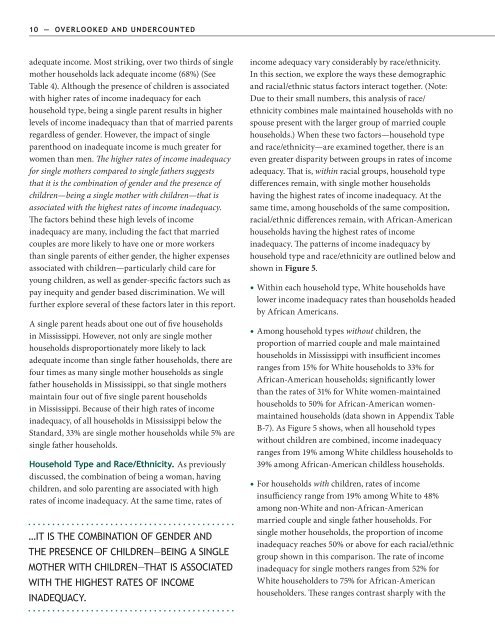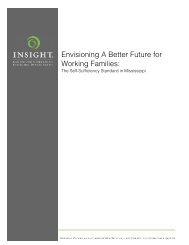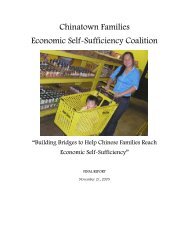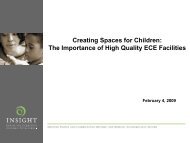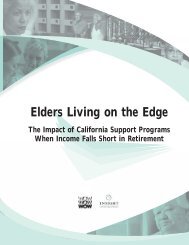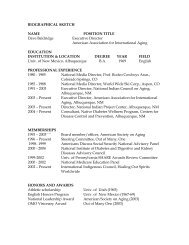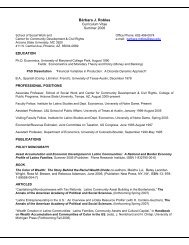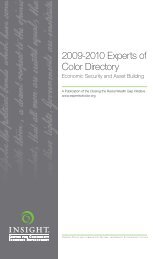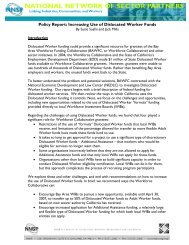Overlooked and Undercounted - Insight Center for Community ...
Overlooked and Undercounted - Insight Center for Community ...
Overlooked and Undercounted - Insight Center for Community ...
You also want an ePaper? Increase the reach of your titles
YUMPU automatically turns print PDFs into web optimized ePapers that Google loves.
10 — OVERLOOKED AND UNDERCOUNTED<br />
adequate income. Most striking, over two thirds of single<br />
mother households lack adequate income (68%) (See<br />
Table 4). Although the presence of children is associated<br />
with higher rates of income inadequacy <strong>for</strong> each<br />
household type, being a single parent results in higher<br />
levels of income inadequacy than that of married parents<br />
regardless of gender. However, the impact of single<br />
parenthood on inadequate income is much greater <strong>for</strong><br />
women than men. The higher rates of income inadequacy<br />
<strong>for</strong> single mothers compared to single fathers suggests<br />
that it is the combination of gender <strong>and</strong> the presence of<br />
children—being a single mother with children—that is<br />
associated with the highest rates of income inadequacy.<br />
The factors behind these high levels of income<br />
inadequacy are many, including the fact that married<br />
couples are more likely to have one or more workers<br />
than single parents of either gender, the higher expenses<br />
associated with children—particularly child care <strong>for</strong><br />
young children, as well as gender-specific factors such as<br />
pay inequity <strong>and</strong> gender based discrimination. We will<br />
further explore several of these factors later in this report.<br />
A single parent heads about one out of five households<br />
in Mississippi. However, not only are single mother<br />
households disproportionately more likely to lack<br />
adequate income than single father households, there are<br />
four times as many single mother households as single<br />
father households in Mississippi, so that single mothers<br />
maintain four out of five single parent households<br />
in Mississippi. Because of their high rates of income<br />
inadequacy, of all households in Mississippi below the<br />
St<strong>and</strong>ard, 33% are single mother households while 5% are<br />
single father households.<br />
Household Type <strong>and</strong> Race/Ethnicity. As previously<br />
discussed, the combination of being a woman, having<br />
children, <strong>and</strong> solo parenting are associated with high<br />
rates of income inadequacy. At the same time, rates of<br />
…IT IS THE COMBINATION OF GENDER AND<br />
THE PRESENCE OF CHILDREN—BEING A SINGLE<br />
MOTHER WITH CHILDREN—THAT IS ASSOCIATED<br />
WITH THE HIGHEST RATES OF INCOME<br />
INADEQUACY.<br />
income adequacy vary considerably by race/ethnicity.<br />
In this section, we explore the ways these demographic<br />
<strong>and</strong> racial/ethnic status factors interact together. (Note:<br />
Due to their small numbers, this analysis of race/<br />
ethnicity combines male maintained households with no<br />
spouse present with the larger group of married couple<br />
households.) When these two factors—household type<br />
<strong>and</strong> race/ethnicity—are examined together, there is an<br />
even greater disparity between groups in rates of income<br />
adequacy. That is, within racial groups, household type<br />
differences remain, with single mother households<br />
having the highest rates of income inadequacy. At the<br />
same time, among households of the same composition,<br />
racial/ethnic differences remain, with African-American<br />
households having the highest rates of income<br />
inadequacy. The patterns of income inadequacy by<br />
household type <strong>and</strong> race/ethnicity are outlined below <strong>and</strong><br />
shown in Figure 5.<br />
Within each household type, White households have<br />
lower income inadequacy rates than households headed<br />
by African Americans.<br />
Among household types without children, the<br />
proportion of married couple <strong>and</strong> male maintained<br />
households in Mississippi with insufficient incomes<br />
ranges from 15% <strong>for</strong> White households to 33% <strong>for</strong><br />
African-American households; significantly lower<br />
than the rates of 31% <strong>for</strong> White women-maintained<br />
households to 50% <strong>for</strong> African-American womenmaintained<br />
households (data shown in Appendix Table<br />
B-7). As Figure 5 shows, when all household types<br />
without children are combined, income inadequacy<br />
ranges from 19% among White childless households to<br />
39% among African-American childless households.<br />
For households with children, rates of income<br />
insufficiency range from 19% among White to 48%<br />
among non-White <strong>and</strong> non-African-American<br />
married couple <strong>and</strong> single father households. For<br />
single mother households, the proportion of income<br />
inadequacy reaches 50% or above <strong>for</strong> each racial/ethnic<br />
group shown in this comparison. The rate of income<br />
inadequacy <strong>for</strong> single mothers ranges from 52% <strong>for</strong><br />
White householders to 75% <strong>for</strong> African-American<br />
householders. These ranges contrast sharply with the


